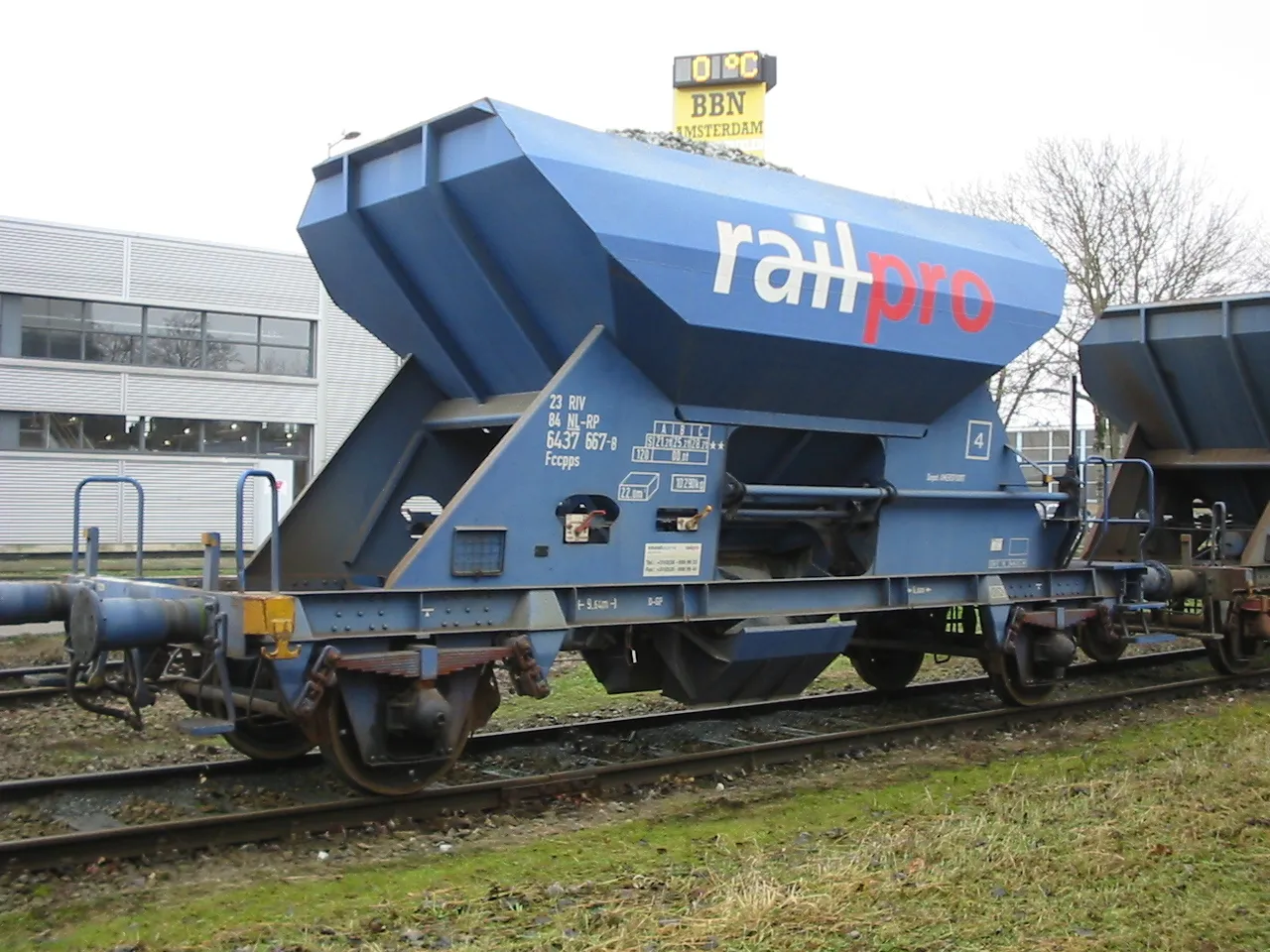
Source: commons.wikimedia.org
1961
The Fccpps is a type of freight wagon used for transporting ballast
material. It is a two-axle self-discharging wagon, designed to
unload ballast into its own track using gravity. Each wagon has two
manually operated hatches at the bottom, allowing controlled
unloading on both the inside and outside of the rail. To reduce
noise from falling ballast, the hatches are lined with rubber for
sound dampening.
The designation Fccpps stands for:
F: Open dumping wagon
cc: Controlled self-unloader with hatches on both sides and in the floor
pp: Axially self-unloading and bottom unloading
s: Maximum speed of 100 km/h
History:
Initially built from 1961 by the German train manufacturer Talbot, 259 or 260 wagons of the Fds/Eds/Fcs type are constructed in the series 50000 - 50259.
From 1986, the wagons are modified by the Hoofdwerkplaats Amersfoort, replacing previous models from the 1940s built by Allan.
Originally owned by the Dutch Railways, they are transferred to Railpro and later Voestalpine Railpro during the 1998 privatization.
Primarily used for maintenance and renewal of the Dutch railway network, some wagons are rented to rail maintenance companies internationally.
Special Modifications:
For the Utrecht–Nieuwegein Sneltram, smaller profile Fccpps wagons were built.
To mitigate dust during dry weather ballast unloading, 34 wagons were equipped with lighting fixtures and a spraying system to prevent dust cloud formation. These wagons form a so-called dust-free unloading train, complete with a water reservoir and pumping installation in a sea container, placed on a Kls type wagon in the train's center.
Incidents:
The Fccpps wagons have been involved in several derailments causing substantial disruption to train services. These incidents occurred in 2005, 2010, and 2013, often due to issues like loose wheel bands or broken wheel bands, leading to significant infrastructure damage and, in some cases, injuries.
The designation Fccpps stands for:
F: Open dumping wagon
cc: Controlled self-unloader with hatches on both sides and in the floor
pp: Axially self-unloading and bottom unloading
s: Maximum speed of 100 km/h
History:
Initially built from 1961 by the German train manufacturer Talbot, 259 or 260 wagons of the Fds/Eds/Fcs type are constructed in the series 50000 - 50259.
From 1986, the wagons are modified by the Hoofdwerkplaats Amersfoort, replacing previous models from the 1940s built by Allan.
Originally owned by the Dutch Railways, they are transferred to Railpro and later Voestalpine Railpro during the 1998 privatization.
Primarily used for maintenance and renewal of the Dutch railway network, some wagons are rented to rail maintenance companies internationally.
Special Modifications:
For the Utrecht–Nieuwegein Sneltram, smaller profile Fccpps wagons were built.
To mitigate dust during dry weather ballast unloading, 34 wagons were equipped with lighting fixtures and a spraying system to prevent dust cloud formation. These wagons form a so-called dust-free unloading train, complete with a water reservoir and pumping installation in a sea container, placed on a Kls type wagon in the train's center.
Incidents:
The Fccpps wagons have been involved in several derailments causing substantial disruption to train services. These incidents occurred in 2005, 2010, and 2013, often due to issues like loose wheel bands or broken wheel bands, leading to significant infrastructure damage and, in some cases, injuries.
Do you have additional informations regarding this vehicle?
Help us writing the history of Fccpps! Your knowledge is precious for us and the entire community, do not hesitate to share your facts, photos or videos:
Latest update on the 18th of November 2023 at 20:31
Contributor(s): Tudor C.
Discussion forum




